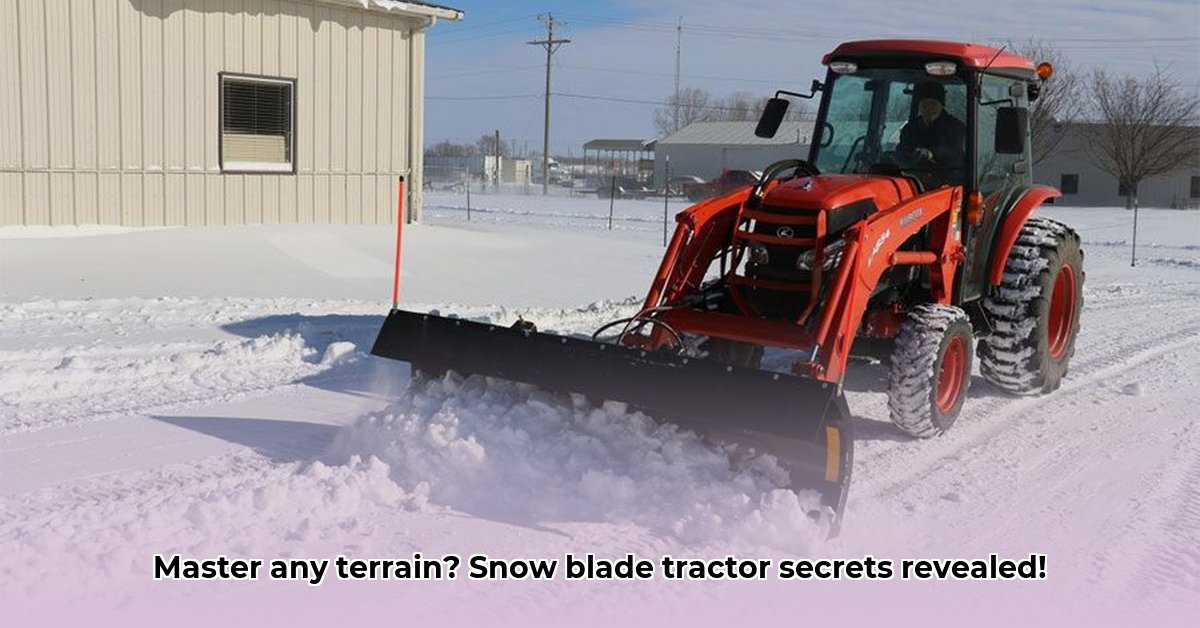
Tired of battling snowdrifts? This comprehensive guide will equip you with the knowledge and skills to master snow blade tractors, regardless of your experience level. From selecting the right machine to performing essential maintenance, we'll cover everything you need to tackle winter's icy grip efficiently and safely. Whether you're a farmer clearing vast fields, a landscaper maintaining pristine landscapes, or a homeowner tackling your driveway, this guide provides the expertise you need. For even more in-depth information, check out this detailed guide.
Choosing the Right Snow Blade Tractor
Selecting the ideal snow blade tractor hinges on your specific needs. Several key factors determine the right choice, influencing both your efficiency and safety.
Matching Size and Power to Your Needs
The size of the area you need to clear is paramount. A smaller tractor, ideal for residential driveways, will struggle with large commercial parking lots or expansive farmlands. Conversely, a large tractor might be cumbersome and impractical in tight spaces. Consider these key size factors:
- Area to be cleared: Residential driveway? Small parking lot? Large farm? The scope of work directly influences tractor size and power.
- Snowfall type: Light, fluffy snow requires less power than heavy, wet snow.
- Budget: Tractors range greatly in price, from under $15,000 to well over $50,000. Balance your budget with your needs.
A crucial metric is the power-to-weight ratio – a higher ratio translates to greater snow-pushing efficiency, especially in heavy, packed snow. Think of it like this: a powerful engine in a lighter chassis provides better maneuverability and efficiency.
| Tractor Horsepower (HP) | Best Suited For | Recommended Blade Width (feet) |
|---|---|---|
| 20-40 | Residential driveways, small lots | 6-8 |
| 40-60 | Larger homes, small farms | 8-10 |
| 60+ | Commercial properties, large farms | 10+ |
Beyond the Tractor: Blade Features and Attachments
The blade itself is a crucial element. Consider these factors:
- Blade width: A wider blade covers more ground per pass, saving time and effort. However, a wider blade might be less maneuverable in tight spaces.
- Angling capabilities: Adjustable angles allow for more precise snow removal and navigating obstacles.
- Interchangeable blades: Some tractors offer different blades (e.g., straight, angled, V-shaped) for varying snow conditions. This adaptability ensures optimal performance in changing winter weather.
Safe Operation: Prioritizing Safety
Safety is paramount when operating any heavy machinery. Adhering to these guidelines ensures your well-being and extends the life of your equipment.
Pre-Operation Checklist: A Foundation for Safety
Before you even start the engine, a thorough pre-operation check is essential:
- Fluid levels: Check engine oil, transmission fluid, and hydraulic fluid levels. Ensure they are within the manufacturer's specified ranges.
- Tire pressure: Maintain proper tire pressure for optimal traction and stability.
- Blade inspection: Examine the blade for any damage, wear, or looseness.
- Control checks: Test all controls (blade lift, steering, throttle) to ensure they function correctly.
- Safety equipment: Wear appropriate protective clothing such as warm layers, gloves, sturdy boots, and a high-visibility vest.
Operation Procedures: A Step-by-Step Guide
- Clear the area: Ensure the area to be cleared is free of obstacles and people.
- Start the tractor: Follow the manufacturer's instructions carefully.
- Engage the blade: Engage the blade slowly and deliberately.
- Safe operation: Maintain a slow, steady pace, avoiding jerky movements. Keep a safe distance from obstacles and other people.
- Visibility: Ensure good visibility; use lights when necessary.
- Regular breaks: Take frequent breaks to prevent fatigue.
Maintaining Peak Performance: Essential Maintenance
Regular maintenance is crucial for the longevity and performance of your snow blade tractor. Preventative maintenance minimizes costly repairs and ensures your equipment operates at peak efficiency.
Routine Maintenance Schedule
- Before each use: Check fluid levels, tire pressure, and inspect the blade and controls.
- After each use: Clean the tractor and blade thoroughly, removing any snow or debris.
- Seasonal maintenance: Perform more comprehensive checks, such as lubricating moving parts and inspecting belts and hoses. Consider professional servicing at the end of winter.
Troubleshooting Common Problems
Even with regular maintenance, issues can arise. Familiarity with common problems and their solutions minimizes downtime and ensures swift resolution.
Addressing Common Mechanical Issues
- Engine won't start: Check the battery, fuel supply, and spark plugs.
- Blade won't engage: Inspect the hydraulic system and controls. This may require professional assessment.
- Tractor losing power: Inspect the air filter and fuel lines for blockages.
- Blade sticking: Lubricate the blade and check for damage.
Remember, if you're unsure how to address a problem, consult a qualified mechanic. Improper repairs can cause further damage and create safety hazards.
Manufacturer Comparisons: Key Considerations
The best snow blade tractor for you depends on individual needs and budget. The following table provides a brief comparison of some popular brands (Note: this is not exhaustive and pricing may vary).
| Manufacturer | Model | Horsepower | Blade Type | Price Range (USD) | Key Features | Considerations |
|---|---|---|---|---|---|---|
| Kubota | BX23S | 23 hp | Various | $15,000 - $20,000 | Compact, maneuverable | Limited power for heavy, deep snow |
| John Deere | 1025R | 25 hp | Various | $20,000 - $25,000 | Versatile, powerful, high quality | Higher price point |
| Mahindra | 1526 | 26 hp | Various | $18,000 - $23,000 | Affordable, reliable, good for larger areas | May require more frequent maintenance |
(Note: Consult manufacturer websites for the most up-to-date information.)
This comprehensive guide provides a solid foundation for mastering snow blade tractors. Remember, prioritizing safety, performing regular maintenance, and understanding your tractor's capabilities are key to efficient and safe snow removal.